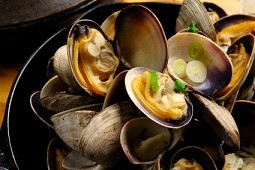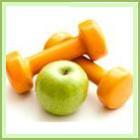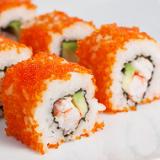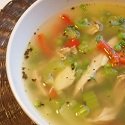Lose Weight
![]() Calories in Food
Calories in Food
![]() Calories in Seafood
Calories in Seafood
![]() Calories in Clams
Calories in Clams
Calories in Clams,
Clam Nutrition Facts
How many calories in Clams? We provide you with the Clam calories for the different serving sizes, Clam nutrition facts and the health benefits of Clams to help you lose weight and eat a healthy diet.
Clams are Molluscs. There are many varieties of Clams, some of which can be eaten raw, otherwise steam them. When steaming, ensure the shell opens, if not, throw them away.
Clams provide an excellent source of vitamin B12, iron and selenium. They also provide a good source of vitamins A, B1-B3, B5, B6, C, copper, manganese, phosphorus, potassium and zinc, plus other vitamins and minerals. The vitamin B12 and Iron content are so good, a 3 ounce serving provides more than 100% of the recommended daily allowance. They also provide a good source of protein.
Clams are low in cholesterol when compared with other seafood, however, 100 grams serving contains approx. 1/5th of the daily recommended intake They are also low in fat.

Clams contain omega-3 fatty acids are believed to help reduce the pain from arthritis and act as an anti-inflammatory. Other Clam benefits are thought to include added protection against heart disease.
Compare calories in Clams with the other calories in seafood.
Calories in Clams, Mixed Species, Raw
Refuse: 0%Scientific Name: Lamellibranchia
| Serving Size | Calories per Serving |
| 100 grams | 86 kcal (360 kJ) |
| 1 cup (with liquid and Clams), 227 grams | 195 kcal (817 kJ) |
| 1 large, 20 grams | 17 kcal (72 kJ) |
| 1 lb (with shell), yield after shell removed, 68 grams | 58 kcal (245 kJ) |
| 1 medium, 14.5 grams | 12 kcal (52 kJ) |
| 1 small, 9 grams | 8 kcal (32 kJ) |
| 3 oz, 85 grams | 73 kcal (306 kJ) |
Calories in Clams, Mixed Species, Cooked, Moist Heat
Refuse: 0%| Serving Size | Calories per Serving |
| 100 grams | 148 kcal (618 kJ) |
| 3 oz, 85 grams | 126 kcal (525 kJ) |
| 20 small, 190 grams | 281 kcal (1174 kJ) |
Clam Nutrition Facts
| Nutritional value per 100 g (3.5 oz) | |
|---|---|
| Proximates: | |
| Water | 63.64 g |
| Energy | 618 kJ (148 kcal) |
| Protein | 25.55 g |
| Carbohydrates | 5.13 g |
| Total Fat: | 1.95 g |
| saturated fat | 0.188 g |
| monounsaturated fat | 0.172 g |
| polyunsaturated fat | 0.552 g |
| Cholesterol | 67 mg (22 %) |
| Minerals: | |
| Calcium, Ca | 92 mg (9 %) |
| Iron, Fe | 27.96 mg (155 %) |
| Magnesium, Mg | 18 mg (5 %) |
| Phosphorus, P | 338 mg (34 %) |
| Potassium, K | 628 mg (13 %) |
| Sodium, Na* | 1202 mg (52 %) |
| Zinc, Zn | 2.73 mg (18 %) |
| Copper, Cu | 0.688 mg (34 %) |
| Manganese, Mn | 1.000 mg (50 %) |
| Selenium, Se | 64.0 mcg (91 %) |
| Vitamins: | |
| Vitamin C | 22.1 mg (37 %) |
| Thiamine (Vit. B1) | 0.150 mg (10 %) |
| Riboflavin (Vit. B2) | 0.426 mg (25 %) |
| Niacin (Vit. B3) | 3.354 mg (17 %) |
| Pantothenic acid (B5) | 0.680 mg (7 %) |
| Vitamin B6 | 0.110 mg (6 %) |
| Folate (Vit. B9) | 29 mcg (7 %) |
| Vitamin B12 | 98.89 mcg (1648 %) |
| Vitamin A | 570 IU (11 %) |
| Percentages are relative to US Recommended Daily Intake (RDI) for adults. | |
* Samples were obtained from 12 retail stores using a probability-based sampling plan. Some fish had been treated during processing to retain moisture on thawing. Untreated fish = 112 mg sodium/100g.
Author: Lana Soko
You Might Also Like:
Like This Page?
|
Share This Page:
|
Search Our Site:

Free E-Book:
We Recommend:
Looking to get your body into great shape? Get the very best results for your efforts and money! Save your valuable time from surfing the internet. These are theBestselling Weight Loss Programs

Programs that work and have thousands of satisfied customers worldwide!
Fat Loss 4 Idiots

Imagine losing in just 11 days up to 9 pounds in weight. You’ll learn how to ensure your metabolism keeps going so your body loses more fat.

 |




